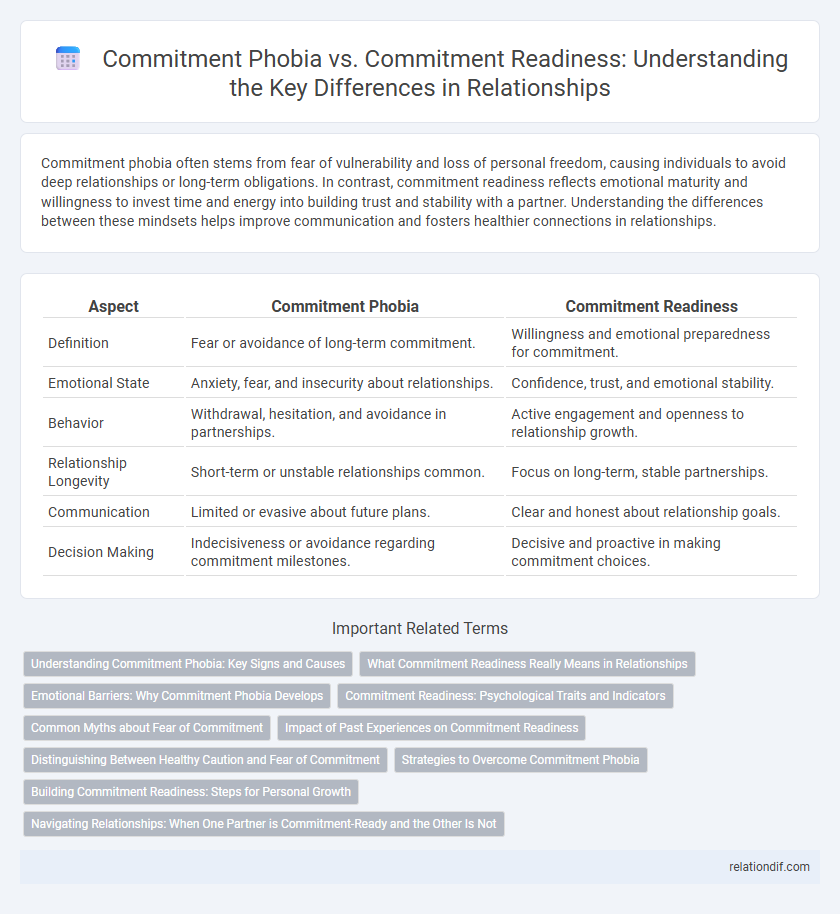Commitment phobia often stems from fear of vulnerability and loss of personal freedom, causing individuals to avoid deep relationships or long-term obligations. In contrast, commitment readiness reflects emotional maturity and willingness to invest time and energy into building trust and stability with a partner. Understanding the differences between these mindsets helps improve communication and fosters healthier connections in relationships.
Table of Comparison
| Aspect | Commitment Phobia | Commitment Readiness |
|---|---|---|
| Definition | Fear or avoidance of long-term commitment. | Willingness and emotional preparedness for commitment. |
| Emotional State | Anxiety, fear, and insecurity about relationships. | Confidence, trust, and emotional stability. |
| Behavior | Withdrawal, hesitation, and avoidance in partnerships. | Active engagement and openness to relationship growth. |
| Relationship Longevity | Short-term or unstable relationships common. | Focus on long-term, stable partnerships. |
| Communication | Limited or evasive about future plans. | Clear and honest about relationship goals. |
| Decision Making | Indecisiveness or avoidance regarding commitment milestones. | Decisive and proactive in making commitment choices. |
Understanding Commitment Phobia: Key Signs and Causes
Commitment phobia manifests through avoidance of long-term relationships, fear of emotional intimacy, and frequent excuses to prevent deep connections, often rooted in past trauma or fear of vulnerability. Individuals struggling with commitment readiness show openness to trust, willingness to invest emotionally, and consistency in maintaining relationship boundaries. Recognizing these key signs helps differentiate between fear-based avoidance and genuine preparedness for committed partnerships.
What Commitment Readiness Really Means in Relationships
Commitment readiness in relationships reflects emotional maturity, self-awareness, and a willingness to invest time and energy into building trust and intimacy. It involves clear communication, consistent actions, and the ability to navigate conflicts constructively without fear of vulnerability. Unlike commitment phobia, which stems from fear of loss and avoidance, commitment readiness fosters long-term connection and mutual growth.
Emotional Barriers: Why Commitment Phobia Develops
Commitment phobia often stems from deep emotional barriers such as fear of vulnerability, past relationship trauma, or low self-esteem, which hinder the ability to form lasting connections. In contrast, commitment readiness involves emotional resilience, trust-building, and the willingness to embrace intimacy despite uncertainties. Understanding these psychological factors is crucial for overcoming resistance and fostering healthy, committed relationships.
Commitment Readiness: Psychological Traits and Indicators
Commitment readiness is characterized by psychological traits such as emotional stability, self-awareness, and a strong capacity for empathy, which facilitate healthy relationship dynamics. Indicators include consistent communication, reliability in actions, and a willingness to invest time and effort into long-term goals. Individuals exhibiting these traits tend to navigate challenges with resilience, fostering trust and intimacy in their commitments.
Common Myths about Fear of Commitment
Fear of commitment is often misunderstood as mere reluctance or a lack of desire for long-term relationships, but it commonly stems from deeper psychological factors like past trauma or attachment issues. Many myths suggest commitment-phobic individuals simply avoid responsibility, yet experts highlight that readiness involves emotional stability and self-awareness rather than impulsiveness. Recognizing that commitment readiness requires emotional resilience dispels the myth that commitment phobia is a personal flaw instead of a complex emotional challenge.
Impact of Past Experiences on Commitment Readiness
Past experiences shape commitment readiness by influencing trust and emotional safety in relationships. Positive, stable relationships encourage openness and security, while past betrayals or abandonment increase fear and hesitation toward commitment. Healing and self-awareness reduce the impact of negative experiences, fostering healthier relationship dynamics.
Distinguishing Between Healthy Caution and Fear of Commitment
Commitment readiness involves a conscious evaluation of compatibility and shared values, indicating emotional maturity and a clear understanding of relationship goals. Commitment phobia, by contrast, stems from fear of vulnerability, past trauma, or anxiety about losing independence, leading to avoidance and indecision. Distinguishing healthy caution from fear of commitment requires assessing whether hesitation is based on thoughtful reflection or underlying emotional barriers that impede trust and long-term connection.
Strategies to Overcome Commitment Phobia
Overcoming commitment phobia requires self-awareness and gradual exposure to vulnerability, building trust through open communication and consistent behavior in relationships. Techniques such as cognitive-behavioral therapy (CBT) help individuals challenge negative beliefs about commitment while setting realistic expectations enhances emotional safety. Establishing clear personal goals aligned with relationship values encourages commitment readiness by fostering confidence and reducing anxiety.
Building Commitment Readiness: Steps for Personal Growth
Building commitment readiness involves cultivating self-awareness and emotional intelligence to overcome fears associated with commitment phobia. Engaging in consistent self-reflection and setting clear personal boundaries enhances trust and confidence necessary for lasting relationships. Developing communication skills and embracing vulnerability are crucial steps towards fostering genuine commitment readiness.
Navigating Relationships: When One Partner is Commitment-Ready and the Other Is Not
Navigating relationships where one partner is commitment-ready and the other exhibits commitment phobia requires clear communication and empathy to bridge differing emotional needs. Commitment-ready individuals often seek stability and long-term planning, while those facing commitment phobia may experience anxiety or fear about losing independence. Understanding these dynamics and fostering mutual respect can help partners find a balance between security and personal freedom.
commitment phobia vs commitment readiness Infographic

 relationdif.com
relationdif.com